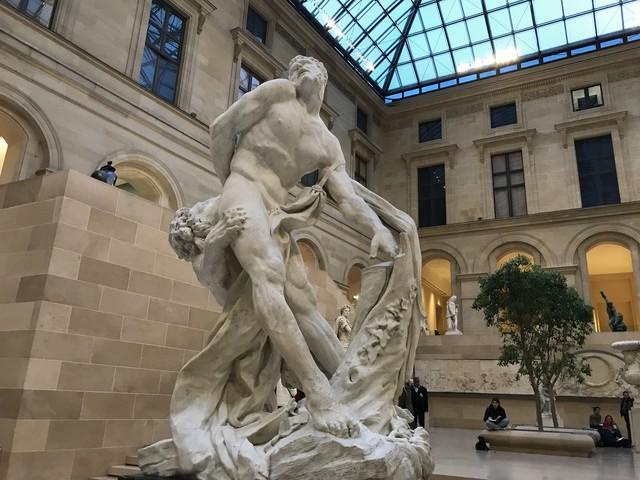Milon of Crotone

Pierre PUGET
Greek athlete several times winner at the Olympic and Pythian Games, aging Milon wanted to test his vigor by splitting a tree trunk already ajar. His hand remained trapped in the trunk and he was devoured by the wolves. Puget replaces them with a lion, a nobler animal, and creates a composition of Baroque vehemence and theatricality: the body writhes in pain and the flesh shudders under its chisel.
The theme, hitherto unknown in sculpture, it is not only a meditation on the Force conquered by Time, but also on the pride of man: Milo is above all vanquished by his vanity, which refuses the weakness of his age. His pain is moral as well as physical. Human glory is ephemeral, as symbolized by the cup won at the Games, which lies on the ground, derisory.
The choice of such a subject for a work intended for the king is rather strange. Puget will reissue audacity, with his bas-relief Alexander and Diogenes, which is in the Louvre.
Even if he works all the faces with equal virtuosity, Puget favors the frontal vision: the work is apprehended face or three quarters. The body of Milon twisted with pain is an immense zigzag: three diagonals of decreasing size fit together and culminate with the head thrown back in a heartrending cry.
© Tourblink
The body is arched against the tree trunk, axis around which pivots the composition. In the center, the marble is pierced by two great days which release the silhouette of the athlete: this recess of the base, rare in sculpture, is a technical feat.
Puget certainly has in mind the Hellenistic Laocoön, a sculpture of the pontifical collections, which constituted for artists the example of heroic pain. The Trojan high priest, an old man, died stoically, suffocated by the serpent sent by the gods. But Puget creates a modern work. He does not idealize the representation of the hero and substitutes for ancient serenity the vehement expression of suffering. The body is arched by pain, the face is nothing more than a grimace, the contracted toes grip the ground.
When the sculpture was unveiled at Versailles in 1683, Queen Marie-Therese would have exclaimed: "The poor man!" The beauty of Puget's chisel makes us forget the marble: the claws of the lion seem to sink into the flesh. The muscles tighten, the veins project, the modulations of the surface give the feeling of the quivering flesh.
The sculptor contrasts the extreme polish of the body with the more brutal treatment of the other elements: the lion's coat is cut with a chisel, the trunk and the ground are streaked at the tip. He thus distinguishes the three protagonists of history by the treatment of the surface: man, beast and nature.